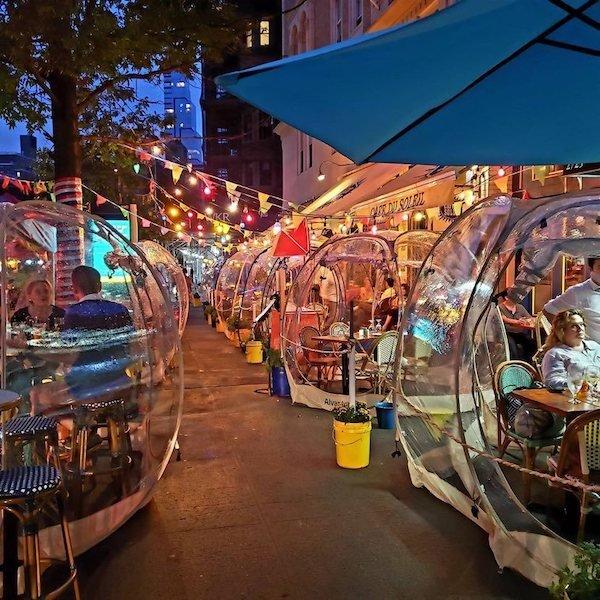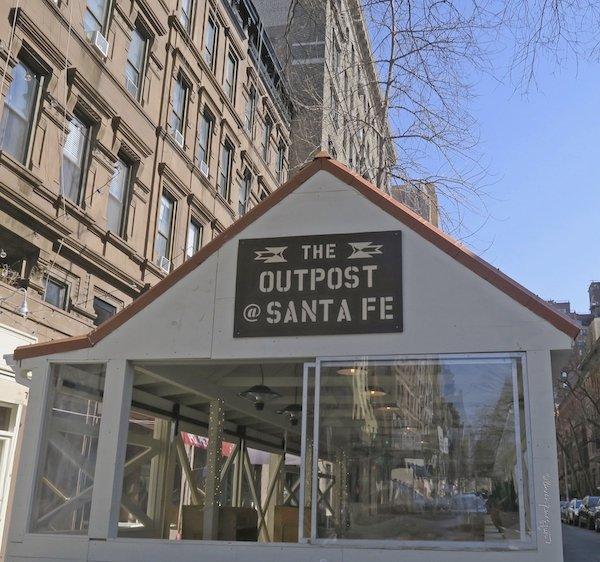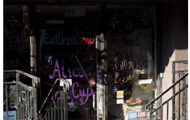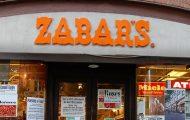
2020: Dining in Space Bubbles at Cafe du Soleil. Photo by @rflnyc
Big changes are coming to outdoor dining on the Upper West Side and across New York City, with the volume of al fresco accommodations expected to plummet dramatically.
Advertisement
Restaurant owners who utilize temporary outdoor dining set-ups have until August 3 to apply to ‘Dining Out NYC’ in order to keep those structures. However, they’ll also need to update their set-ups to be in compliance with new requirements by November 1 of this year–or within 30 days of approval for their Dining Out NYC application–whichever date is sooner.
View this post on Instagram
Here are some of the forthcoming changes:
- Enclosed structures are now banned.
- Set-ups that utilize temporary outdoor flooring must remove and clean the area under the flooring weekly.
- All roadway dining sheds must be removed between November and April. Sidewalk set-ups will continue to be allowed year round.
- Restaurants which are granted permission for outdoor set-ups must pay fees to the city. A four-year license for a roadway or sidewalk cafe is $1,050, or $2,100 for both.
- Non-compliant restaurants will be fined anywhere from $500 to $1,000 for each offense.
Streetsblog NYC reports that of the thousands of NYC restaurants that currently have outdoor dining setups–a number which peaked at more than 12,000 during the height of Covid–only 23 have gotten to the stage of the application that requires a public hearing (as of July 12). Public hearings are required for restaurants that want to maintain roadway dining set-ups, but are not always necessary for restaurants with sidewalk dining. The city told Streetsblog that it has received “hundreds of applications.”
Advertisement
“I think the city is working hard and doing their best, but it’s really messy,” said Jeremy Wladis of The Restaurant Group, who owns quite a few UWS establishments including Harvest Kitchen (269 Columbus Avenue) and Good Enough To Eat (520 Columbus Avenue). “I’ve got one person working on this for two weeks trying to take measurements in the street and the sidewalk while dealing with the application processes.”
Wladis also told ILTUWS that the new guidelines are going to be a deal breaker for some restaurants. “Before, you needed 8 feet of clearance from the last seat to the curb; now it’s 10 feet. So some places which have had sidewalk cafes for years won’t be eligible.”

2021: An elaborate outdoor dining structure at Santa Fe. Photo by Patricia Youngquist.
We also spoke with Michael Trenk, one of the owners of Prohibition (503 Columbus Avenue), who told us the sidewalk cafe they’ve been operating for the last 28 years will likely end up with six fewer seats as a result of the changes. But for now, he’s doing business as usual.
“I don’t want to be a pioneer when it comes to building a new structure that they won’t approve,” Trenk told us, adding that there’s a fair amount of murkiness around the new rules and regulations and that they’re likely to change. Trenk and his partners took a similarly cautious approach during Covid, keeping Prohibition closed until they were one-hundred percent sure it was safe to reopen–at which point they welcomed their patrons back to a completely renovated space with a new theme, new drinks, and new food.
Advertisement
“Since the DOT has been running the program there have been a lot of changes and I think a lot of unintended consequences. The cafes are going to be much smaller, which means less revenue for the restaurants and the city,” said Jeffrey Bank, the CEO of Alicart Restaurant Group which operates Carmine’s and Virgil’s Real BBQ on the UWS. “For instance, cafes under the new DOT rules are not allowed under scaffolding because of the poles/space, even though they have been under scaffolding for decades and we know scaffolding never comes down. The roadway cafes will also be much smaller with much more complicated rules as well. It’s odd considering the current ones have been up for over three years now with no safety issues (except some are an eyesore, which the city can force the owner to clean up or remove). So I’m not sure why DOT needs to make them smaller after collecting 3+ years of data, it’s clearly not a safety issue. Cafes promote activity in the neighborhood which makes it safer out at night. Seems odd based on the empty storefronts and higher crime we are seeing to not want safer streets. Most restaurants need these seats to survive, you will start to see a falling out of marginal restaurants when the new rules take effect. That said, the bright side is that the fees are less than before the pandemic.”
Restaurant owners can visit the Dining Out NYC website to view the new regulations, see examples of permitted outdoor structures, and apply. The new regulations, along with the application process itself, have frustrated many restaurant owners.
The city has positioned these changes as an effort to improve outdoor dining and make it more permanent.
“Outdoor dining enhances our communities, and we’re excited to make it a permanent feature of New York City streets,” NYC DOT Commissioner Ydanis Rodriguez said in a statement. “We have made it easy to participate through our online application portal and additional resources and guidance are available.”
Residents continue to share mixed feelings about the prevalence of outdoor dining.
“I live on the upper west side and there are plenty of restaurants that have both sidewalk and street space and neither of them are full,” said R Garrin. “Our streets have become a total menace. lets do whatever we can to make them safer and cleaner and start by getting rid of unnecessary street sheds.”





I get it. The initial shacks were intended to be temporary but were not built to last several years and seasons. Some harbor rats.
Refurbish them to health and safety standards. Keep them clean. All reasonable requirements.
Some have done a really good build job with proper electrical conduits and ventilation.
I don’t get the prohibition of being enclosed. It helps keep the noise down for nearby residences. That seems a no-brainer.
I feel terrible for what the restaurants endured in 2020 and 2021. I hope that keeping those structures in 2022 and 2023 (and 2024) helped them recoup their losses. But it’s time.
There are sidewalks on the UWS where people literally cannot pass due to the waiter traffic, shed, sidewalk cafe, etc. A taxpayer-funded sidewalk where people cannot walk.